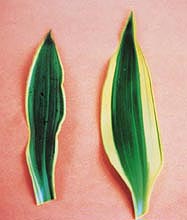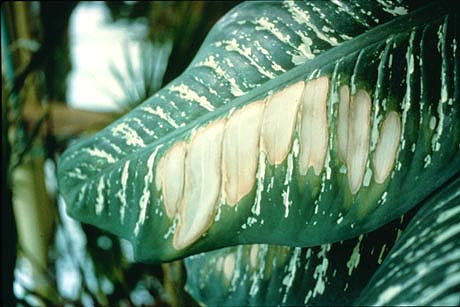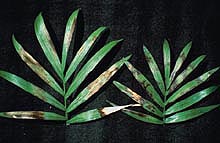Light obviously affects the growth of all plants and is one of the most important factors in production and in the interiorscape. However, little research has been published concerning foliage plant "diseases" caused by inappropriate levels of light.
Plants such as Codiaeum variegatum (L.) Blume (croton) do not develop optimal color if the light is too high or too low. Others, such as Calathea spp., are stunted and chlorotic when grown with too much light, even at levels that may be suitable for many other foliage plants.
|

Fig. 2. Leaf of Dracaena sanderana produced under low light (left) and thicker, stronger leaf produced under more light (right). Used by permission of Florida Foliage Association. From the Compendium of Ornamental Foliage Plant Diseases.
|
In contrast, some foliage plants, such as Ficus benjamina L. (weeping fig), tolerate a wide range of light levels during production. This growth tolerance, however, can create problems for interiorscapers, since Ficus produced under full sun adapts poorly to the low light levels of an interiorscape, generally losing most of its leaves, and may even die. Ficus produced under lower light levels, however, may have thin, elongated branches and an undesirable form. For this reason, Ficus is often produced under full-sun conditions and "acclimatized" under lower light to create attractive plants for interiorscapes. Similarly, Dracaena sanderana Hort. Sanderex M. T. Mast. (Belgian evergreen) has shorter, thicker, stronger leaves when grown under full sun than when grown in shade (Fig. 2), and the plants grown in full sun are more compact and have shorter internodes.
Another effect of light is its influence on the amount of fertilizer a plant requires. Plants produced under high levels of light utilize more fertilizer than those produced under low light. Thus a plant moved from full sun to shade can develop fertilizer toxicity, and a plant moved from low light into a stronger light can become chlorotic and under fertilized.
Rapid changes in light level from one extreme to another frequently result in leaf abscission, bleaching, and necrosis.
|

Fig. 3. Sunscald on Dieffenbachia. From Foliage Plant Disease: Diagnosis and Control.
|
|
Plants exposed to a substantial increase in light can develop necrotic areas (Fig. 3). Even plants that can be produced in full sun, if they are grown in the shade, burn if exposed even briefly to full sun (Fig. 4). Low light also causes severe damage to some foliage plants, although the damage may take longer to become apparent.
|

Fig. 4. Foliar necrosis of Chamaedorea elegans moved from 80% shade to 47% shade. (Click image for expanded view). |
|
Selected References
Conover, C. A., and Poole, R. T. 1972. Influence of shade and nutritional levels on growth and yield of Scindapsus aureus, Cordyline terminalis 'Baby Doll' and Dieffenbachia exotica. Proc. Am. Soc. Hortic. Sci., Trop. Reg. 16:277-281.
Conover, C. A., and Poole, R. T. 1981. Influence of light and fertilizer levels and fertilizer sources on foliage plants maintained under interior environments for one year. J. Am. Soc. Hortic. Sci. 106(5):571-574.
Conover, C. A., and Poole, R. T. 1984. Light and fertilizer recommendations for production of acclimatized potted foliage plants. Foliage Dig. 8(8):1-6.
Conover, C. A., Poole, R. T., and Nell, T. A. 1982. Influence of intensity and duration of cool white fluorescent lighting and fertilizer on growth and quality of foliage plants. J. Am. Sec. Hortic. Sci. 107(5):817-822.
Fails, B. S., Lewis, A. J., and Barden, J. A. 1982. Anatomy and morphology of sun- and shade-grown Ficus benjamina. J. Am. Soc. Hortic. Sci. 107(5):754-757.
RETURN TO APSnet FEATURE STORY
